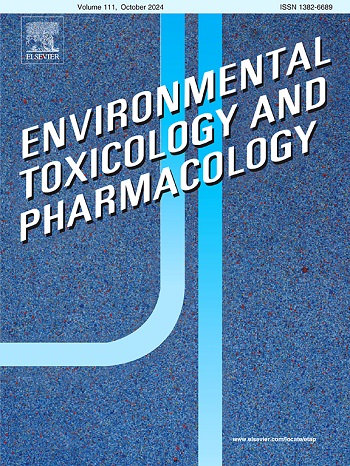环境污染和对非正式工人的健康风险:接触印度尼西亚垃圾填埋场人类头发中的重金属
IF 4.2
3区 环境科学与生态学
Q2 ENVIRONMENTAL SCIENCES
引用次数: 0
摘要
人类头发中的重金属浓度是工人(包括垃圾填埋场的非正式工人)长期污染环境的生物指标。垃圾填埋场是存放、运输和处理城市固体废物的最后阶段。没有对垃圾填埋场中的重金属及其对非正式工人的健康影响进行研究。本研究旨在调查重金属在长时间内的积累,有毒金属暴露对人体的影响,以及非正式工人认为的垃圾填埋场污染生物指标的健康风险。采用电感耦合等离子体质谱法(ICP-MS)测定日本国立环境研究所提供的人体头发质量标准物质(CRM)和人体头发质量标准物质。样本由接受采访并剪了头发的人组成。本次研究的调查对象总数为51人。非正式工人体内重金属元素的平均浓度(µg/g)为:Pb 4.70, As 0.30, Cd 1.07, Mn 14.58, Co 0.14, Cu 19.31, Fe 73.05, Zn 646.2, Se 0.65。我们的研究结果表明,重金属浓度高于城市居民。在受教育程度变量中,17.4% %的受访者没有上学,50% %的受访者上过小学,32.6% %的受访者上过初中。受访者性别中,71.7 %为女性,在工作期间,69.6% %为十岁以上。流行病学研究和统计分析显示了受访者的症状& &;健康抱怨,如咳嗽、呼吸困难、头痛、鼻子刺激、更换口罩、使用口罩的持续时间,以及被调查者与所有金属浓度的显著相关性p值<; 0.05的特征。这些调查结果表明,甲基溴已污染环境并进入人体,对垃圾填埋场工作区域的非正规工人构成健康风险。本文章由计算机程序翻译,如有差异,请以英文原文为准。
Environmental pollution and health risks to informal workers: Exposure to heavy metals in human hair at Indonesian landfills
The concentration of heavy metals (HMs) in human hair is a bioindicator of environmental pollution over a long period from worker, including the informal worker at landfills. A landfill is where final-stage refuse is deposited, transported, and disposed of solid waste from urban areas. No study has been conducted on heavy metals in landfills and their health impact on informal workers. This study aims to investigate the accumulation of heavy metals over a long period, the effect of toxic metal exposure on the human body, and the health risks informal workers perceive as bioindicators of pollution in landfills. Human hair samples collected from informal workers and urban were analyzed by inductively coupled plasma mass spectrometry (ICP-MS) to measure HMs and human hair certified reference material (CRM) from the national institute for environmental studies, Japan. The sample consisted of individuals who were interviewed and had their hair cut. The total number of respondents in this study was 51 people. The average concentrations of the element heavy metals (µg/g) in informal workers are shown: Pb 4.70, As 0.30, Cd 1.07, Mn 14.58, Co 0.14, Cu 19.31, Fe 73.05, Zn 646.2, and Se 0.65. The results of our study the concentrations of heavy metals were higher than those found for urban residents. In the education level variable, 17.4 % of respondents did not attend school, 50 % attended primary school, and 32.6 % attended junior high school. Gender of respondents, 71.7 % are female, and in the working period, 69.6 % are more than ten years old. An epidemiological study and statistical analysis show the respondents' symptoms & health complaints such as cough, breathlessness, headache, nose irritation, variable mask, duration using a mask, and characteristics of the respondent's significant correlations p-value < 0.05 with a concentration of all metals. These findings show that the HMs have contaminated the environment and entered the human bodies, posing health risks to informal workers in the landfill working area.
求助全文
通过发布文献求助,成功后即可免费获取论文全文。
去求助
来源期刊
CiteScore
7.00
自引率
4.70%
发文量
185
审稿时长
34 days
期刊介绍:
Environmental Toxicology and Pharmacology publishes the results of studies concerning toxic and pharmacological effects of (human and veterinary) drugs and of environmental contaminants in animals and man.
Areas of special interest are: molecular mechanisms of toxicity, biotransformation and toxicokinetics (including toxicokinetic modelling), molecular, biochemical and physiological mechanisms explaining differences in sensitivity between species and individuals, the characterisation of pathophysiological models and mechanisms involved in the development of effects and the identification of biological markers that can be used to study exposure and effects in man and animals.
In addition to full length papers, short communications, full-length reviews and mini-reviews, Environmental Toxicology and Pharmacology will publish in depth assessments of special problem areas. The latter publications may exceed the length of a full length paper three to fourfold. A basic requirement is that the assessments are made under the auspices of international groups of leading experts in the fields concerned. The information examined may either consist of data that were already published, or of new data that were obtained within the framework of collaborative research programmes. Provision is also made for the acceptance of minireviews on (classes of) compounds, toxicities or mechanisms, debating recent advances in rapidly developing fields that fall within the scope of the journal.

 求助内容:
求助内容: 应助结果提醒方式:
应助结果提醒方式:


